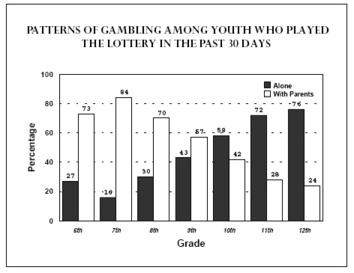The nature of an individual’s initial exposure to gambling may influence his or her long-term attitudes towards gambling. Little empirical research has been done in this area. Recently, a few studies have explored one aspect of gambling initiation, the people who participate in gambling with youth or who encourage youth to gamble. The annual Survey of Quincy Youth* surveyed 3067 sixth through twelfth graders about their participation in gambling as well as use of alcohol and other drugs. A quarter (25%) of this sample had played the lottery in the past 30 days. Of these 767 students, those in lower grade levels played the lottery with their parents, while older students generally played the lottery alone. This survey gave the students only these two options, which may have resulted in some misclassification. For example, some students who gambled with a sibling may have interpreted “alone” as meaning “not with parents”, and therefore selected “alone”, resulting in an overestimation of the percentage of youth who gamble “alone.” Another school-based student survey** of 506 middle-school students in suburban Massachusetts found that 44.6% of students who remembered the first time they gambled had gambled with their family. Some had gambled with a parent (15.1%), some had gambled with a sibling (9.4%), and others had gambled with another family member (20.1%). Playing the lottery in Massachusetts is illegal for youth under 18 years old. In addition, between 9.9% and 14.2% of adolescents are at risk of developing or returning to serious gambling problems while between 4.4% and 7.4% of adolescents exhibit pathological patterns of gambling behavior***. These figures suggest that families and communities should examine the role and meaning of gambling for children when gambling is a family activity.
Sources adapted from:
*Impact Quincy. (1995). 1995 survey of Quincy youth. Quincy, MA: Quincy Coalition for the Prevention of Alcohol, Tobacco, & other Drug Problems.
**Vagge, L.M. (1996). The development of youth gambling. Unpublished Honors Thesis, Harvard-Radcliffe Colleges, Cambridge, MA.
***Shaffer, H.J. & Hall, M.N. (1996). Estimating the prevalence of adolescent gambling disorders: A quantitative synthesis and guide toward standard gambling nomenclature. Journal of Gambling Studies, 12(2), 193-214.
This public education project is funded, in part, by The Andrews Foundation.





